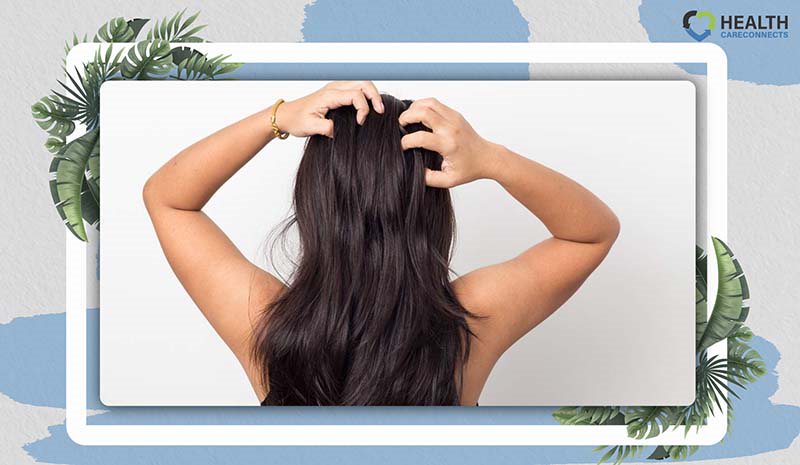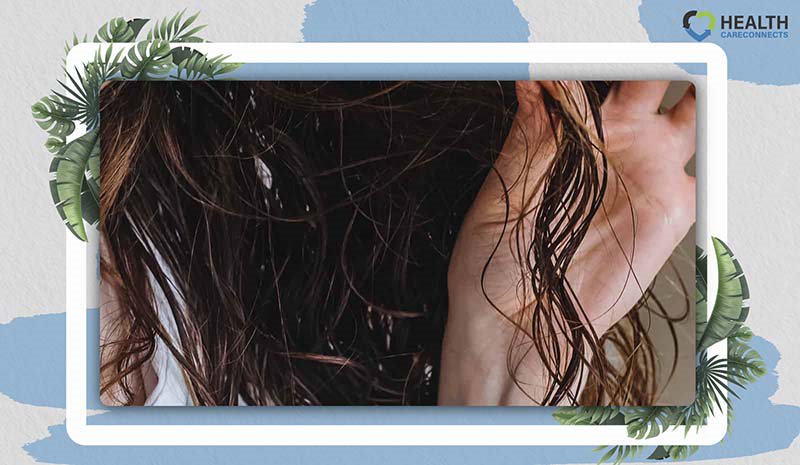Heat damage is a common but frequently ignored issue that can significantly affect your hair’s health. Regular use of hot styling tools such as hairdryers, straighteners, and curling irons can cause split ends, loss of shine, and even hair loss.
In this guide, we will explore the causes of heat damage, how to recognize it, and provide practical advice on how to fix heat damaged hair and prevent future issues.
Signs of Heat Damaged Hair
Heat damage can present itself in several ways, each a clear indicator of the stress your hair has endured. Recognizing these signs is crucial for taking remedial action. Here are the common symptoms of heat-damaged hair:
- Dry and Brittle Hair: When hair loses its natural moisture, it becomes dry and prone to snapping when pulled or combed.
- Split Ends: The ends of hair strands split into multiple pieces, signaling the breakdown of the hair’s protective layer.

- Dull and Lackluster Hair: Healthy hair shines naturally, while heat-damaged hair appears dull and lifeless.
- Tangled and Frizzy Hair: Damaged hair cuticles tend to lift, causing tangles and frizz.
- Lack of Hair Elasticity and Resilience: Healthy hair can stretch and return to its original form. Damaged hair loses this elasticity, making it less pliable and more prone to breaking.

- Breakage: Heat damage weakens the hair strand, causing it to break at various points, not just the ends. It’s important to differentiate between hair loss from the root and hair breakage. The latter, often due to heat damage, means the hair breaks off along the strand, but heat treatment does not impact the hair follicle’s growth cycle.
- Rough Texture: Damaged cuticles result in hair that feels coarse to the touch.
- Incorrect/Uneven Hair Color: Excessive heat styling, especially on color-treated hair, can lead to color fading. Heat can degrade some of the dye, and damaged cuticles can cause water-soluble dyes to wash out more easily, resulting in uneven or faded hair color.
The Cause of Hair Damage Is Heat
Heat-damaged hair can result from a combination of styling practices and environmental factors. Here are the top causes:
- Overuse of Heat Styling Tools: Regular and prolonged use of straighteners, curling irons, and hair dryers exposes hair to high temperatures. According to a study on hair degradation in the medical journal Polymers, “Blow-drying the hair [without heat protectants] causes the scale edges to become concave-shaped due to cuticle layer splitting” and “Thermal straightening promotes overheating of the hair shaft, causing weakening and rupture.” Without moderation or proper techniques, these tools can cause significant stress and damage to the hair.
- Lack of Heat Protection: Protective products should be applied before styling. Skipping this step means your hair faces the full brunt of the heat without a safeguard, leading to quicker and more severe damage.
- Frequent, Intense Chemical Treatments: Coloring and perms involve chemicals that alter hair structure. Frequent treatments can weaken hair, making it more susceptible to heat damage.
- Environmental Factors: Persistent sun exposure can also harm hair health. Just as skin can burn and become damaged from the sun, hair too can suffer when exposed to UV rays for extended periods.
How to Fix Heat Damaged Hair
Repairing heat-damaged hair requires a comprehensive approach. The damage might be multifaceted, so the solution must be well-rounded. Here’s a detailed guide on steps you can take:
Experiment with an Oil Soak Treatment for Your Hair
Using natural oils like coconut, argan, or almond oil can help nourish and restore moisture to heat-damaged hair.
Apply the oil to your hair, covering it from roots to ends, and leave it on for at least an hour or overnight before washing it out. This treatment can help replenish essential fatty acids and minerals to the damaged hair follicles.
Integrate Protein Treatments to Fortify Your Hair
Protein treatments are vital for repairing the structure of your hair shaft.
Products containing keratin or other protein-based ingredients can help reinforce the hair cuticle, making it less susceptible to damage. Apply a protein treatment once a week to help repair and protect your hair.

Establish Deep Conditioning as a Consistent Element of Your Hair Care Regimen
Deep conditioning treatments are crucial for restoring hydration to dry, brittle hair.
Use a high-quality deep conditioner suited for your hair type, and apply it following the instructions—usually, this means leaving the conditioner on for about 20-30 minutes. Regular deep conditioning can significantly improve hair texture and elasticity.
Opt for Natural Shampoo Options
Switch to shampoos that are free from harsh chemicals such as sulfates and parabens, which can strip your hair of its natural oils and exacerbate damage.
Natural or organic shampoos containing nourishing ingredients like aloe vera, shea butter, or tea tree oil can help soothe and repair your scalp and hair.

Decrease the Frequency of Heat Styling Tools to Safeguard Your Hair from Damage
This doesn’t mean you can never heat style your hair again, but it’s best to avoid using heat on damaged hair if you want it to bounce back. So, pack up those tools until your hair is in healthier shape.
How Can You Prevent Heat Damage to Your Hair?
The best way to deal with heat-damaged hair is to prevent it altogether. While avoiding heat damage entirely may not always be possible, there are several proven strategies to protect your hair:
- Rinse Your Hair with Cool Water: After showering, rinse your hair with cool water to help seal the hair cuticle, which can reduce damage and maintain moisture.
- Maintain Distance with Your Blow Dryer: Keep your blow dryer at least 5 inches from the surface of your hair while using it. A 2011 study found that this distance can protect the hair follicle and might even be better than air-drying.
- Use a Microfiber Towel: After washing your hair, use a microfiber towel to help speed up the drying process. This reduces the time needed under a blow dryer and helps seal the hair cuticle, minimizing frizz and damage.
- Apply Heat Protectant Spray: Before using hot styling tools, spray a heat protectant on your hair. Products containing silicone and keratin can seal the hair cuticle, making it more resistant to heat damage.
- Sleep on a Satin Pillowcase: Using a satin pillowcase can help your hairstyle last longer, meaning your hair is less tangled in the morning and has to be washed less often. This, in turn, reduces the need for hot styling tools. Experts recommend limiting the use of hot styling tools to once per week.
Is Heat Damage Permanent?
The impact of heat on hair varies with the extent of the damage. For mild cases of heat damage, where hydrogen or ionic bonds within the hair strands are impacted, recovery is possible.
These bonds are designed to break and reform naturally, facilitating the ability to alter hair’s shape during styling processes like curling or straightening.
On the other hand, severe heat damage affects the hair’s disulfide bonds. Once these bonds are broken, the damage is irreversible, leading to permanent changes in the hair’s structure and strength.
Conclusion
Heat damage may pose challenges, but it doesn’t mean you can’t reclaim the health of your hair. Integrating deep conditioning treatments and adjusting your hair care practices can significantly aid in repairing your hair’s natural texture and luster.
Remember, restoring heat-damaged hair requires patience and persistence. By adhering to these steps on how to fix heat damaged hair, you’ll gradually see a transformation towards stronger, more vibrant hair.
For those seeking more information and honest product reviews, I recommend visiting HealthCareConnect.

Dr. Joyce Slater: Your Guide to Informed Health Choices
Dr. Joyce Slater shines as a distinguished expert in the field of nutrition and public health. Contributing her vast expertise to HealthConnectbc, she embodies a deep-seated passion for enhancing public well-being. As a respected figure in her field. Dr. Slater’s academic journey and professional achievements are nothing short of inspirational.
Holding a significant position as a researcher and educator, Dr. Slater has delved deeply into the intricacies of food literacy and nutritional science. Her work, prominently featured in numerous esteemed scientific publications, underscores her dedication to expanding our understanding of food’s role in health and society.
At the heart of Dr. Slater’s professional ethos is a profound desire to positively impact individual lives through education and research. She often says, “Empowering people with the knowledge to make healthier choices is the most rewarding aspect of my work.” This principle is the cornerstone of her involvement with HealthConnectbc, where she strives to provide reliable and practical health advice.
Dr. Slater’s contributions to HealthConnectbc are multifaceted: academically, she offers insights into the complex world of nutrition and health, enhancing both public understanding and professional practices. Additionally, she is instrumental in guiding and inspiring the next generation of health professionals, thus fostering future excellence in the field.
Juggling rigorous research with her educational duties, Dr. Slater demonstrates an unwavering commitment to her profession. Her approachable nature and genuine concern transcend the confines of academia, touching the lives of everyone she interacts with. Dr. Slater looks forward to continuing her journey of discovery and education, dedicated to the ongoing improvement of public health and nutrition.
At HealthConnectbc, Dr. J. Slater is not just a contributor; she is a guiding light, dedicated to enlightening and motivating individuals towards a healthier and more informed lifestyle.
PUBLISHED ARTICLES
- Food literacy competencies: A conceptual framework for youth transitioning to adulthood (2018)
- Self-perceived eating habits and food skills of Canadians (2016)
- Challenges to acquiring and utilizing food literacy: Perceptions of young Canadian adults (2016)
- Socio-demographic and geographic analysis of overweight and obesity in Canadian adults (2009)
- Sustainable well-being: Concepts, issues, and educational practices (2014)

